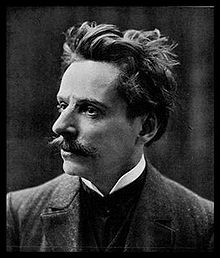music.wikisort.org - Composer
Enric Morera i Viura (Catalan pronunciation: [ənˈriɡ muˈɾeɾə]; 22 May 1865 – 11 March 1942[1]) was a Spanish musician and composer.
This article may be expanded with text translated from the corresponding article in Catalan. (March 2015) Click [show] for important translation instructions.
|

Career
Morera was born in Barcelona but moved with his father, a musician, to Buenos Aires, Argentina in 1867, studying organ, trumpet, and violin there. He returned in 1883 to Barcelona, studying with Isaac Albéniz and Felip Pedrell. Later he lived for two years in Brussels before returning to Argentina. He finally returned to Barcelona in 1890 where he was prominent in the movement Catalan Musical Modernism, with for example the opera La fada (The Fairy) in 1897. He founded the choir "Catalunya Nova". He wrote books on musical theory such as a "Practical Treatise on Harmony".
Among his students were Vicente Asencio, Agusti Grau, Manuel Infante, Xavier Montsalvatge and Carlos Surinach.
His music is generally strongly nationalist in character and forms part of the repertory of Catalan national compositions. He wrote more than 800 compositions, including songs, a requiem mass, lyric works, symphonic works, operas, symphonic poems, and sardanes for cobla.
Although he spent some time in Argentina and Belgium, Morera spent most of his life in Barcelona and died there in 1942.
The personal papers of Enric Morera are preserved in the Biblioteca de Catalunya.
Selected compositions
- Dansa del gnoms, 1893
- Introducció a l'Atlántida, symphonic poem, 1893
- Minuet per a quartet de corda, 1889
- Jesús de Nazareth, 1894
- La fada, opera, 1897
- L'alegria que passa, 1898
- Missa de rèquiem, 1899
- La nit de l'amor, 1901
- El comte Arnau, 1905
- Bruniselda, 1906
- Empòrium, opera, 1906
- Don Joan de Serrallonga, 1907
- La Santa Espina, patriotic song and sardana, 1907
- Cançons populars catalanes harmonitzades, 1910
- Titaina, opera, 1912
- Tassarba, opera, 1916
- Concert per a violoncel i orquestra (cello concerto), 1917
- El poema de la nit i el dia i de la terra i de l'amor, symphonic poem, 1920
- Cançons de career, 1926
- La marieta de l'ullviu, 1926
- La cançó dels Catalans, 1930
- El castell dels tres dragons, 1931
- Dotze cançons del Llibre de la Pàtria, 1936
See also
- Conservatori Superior de Música del Liceu
- Escola Municipal de Música
- Sardana
References
- "Obituary". La Vanguardia. 20 March 1942. p. 4.
Bibliography
- Aviñoa, Xosé: Morera (Barcelona: Nou Art Thor, 1985) (= Gent Nostra, vol. 37) (in Catalan)
- Morera, Enric: Moments viscuts (auto-biografia) (Barcelona: Gráficas Barcelona, 1936), (in Catalan)
- Pena, Joaquim: Enric Morera : assaig biogràfic (Barcelona: Institució del Teatre, 1937) (= Estudis Institut del Teatre, vol. 17) (in Catalan)
- Planes, Ramon: El mestre Morera i el seu món (Barcelona: Pòrtic, 1972) (= Llibre de butxaca, vol. 55), (in Catalan)
- Saperas, Miquel: El mestre Enric Morera (Andorra la Vella & Barcelona: Editorial Andorra, 1969) (= Collecció Ahir-Demà, vol. 4), (in Catalan)
External links
- Enric Morera i Viura: Biography and Works
- Personal papers of Enric Morera in the Biblioteca de Catalunya
- PDF scores and mp3 music
На других языках
[de] Enric Morera
Enric Morera i Viura (* 22. Mai 1865 in Barcelona; † 11. März 1942 ebenda) war ein katalanischer Komponist.- [en] Enric Morera i Viura
[es] Enric Morera i Viura
Enric Morera i Viura (Barcelona, 22 de mayo de 1865 - 11 de marzo de 1942[1]), compositor y músico español. Escribió óperas, música escénica, obras sinfónicas, obra coral, conciertos y una Missa de rèquiem, pero sobre todo es reconocido por sus sardanas corales con títulos tan populares como La Santa Espina, Les fulles seques, La sardana de les monges y L'Empordà. Su obra se adscribe en la estética neo-romántica y es una magnífica muestra del nacionalismo musical catalán. Tan es así, que escribió en catalán (en lugar del italiano), todo lo concerniente a tempos, dinámica, agógica, etc. También es de destacar la no utilización de armadura de clave en sus canciones. Todas las alteraciones son accidentales, optando por esta forma de escritura, como otros compositores de su tiempo.Другой контент может иметь иную лицензию. Перед использованием материалов сайта WikiSort.org внимательно изучите правила лицензирования конкретных элементов наполнения сайта.
WikiSort.org - проект по пересортировке и дополнению контента Википедии